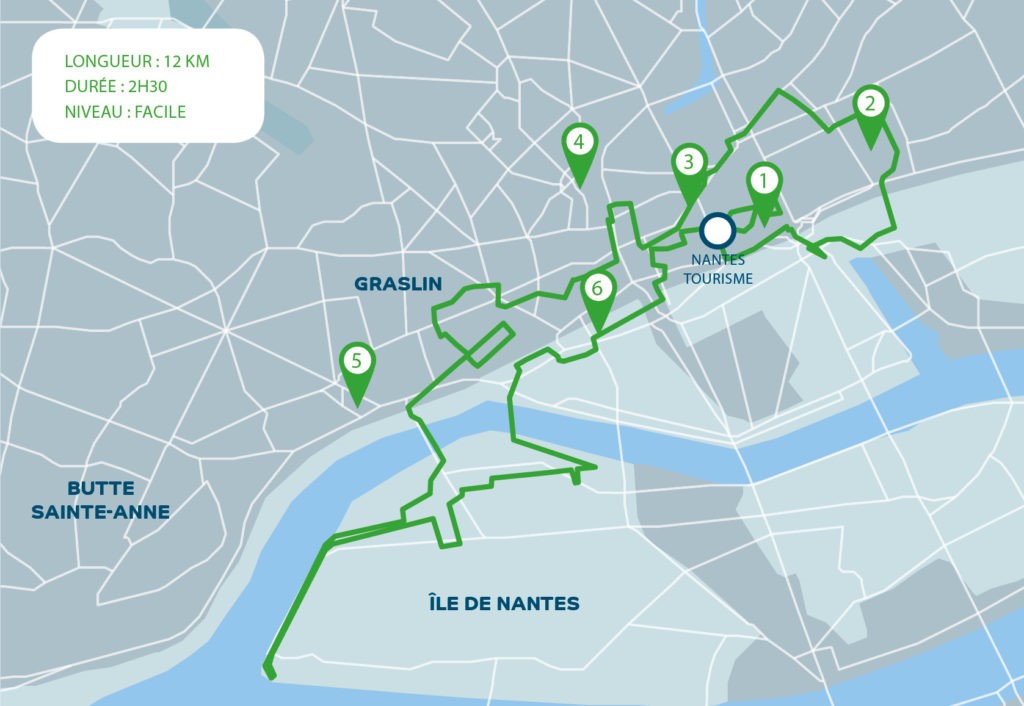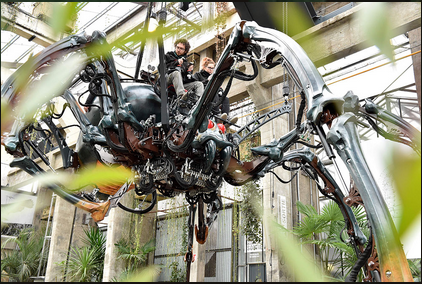Nantes – Cité des Ducs de Bretagne
At first sight, we might think that Nantes in not an attractive city. However, she is full of activities and unknown secrets. We are going to present you some of them.
Ranked 6th in term of population (320,000 people living in Nantes in 2019), the city is situated in the north-west of France, just below Brittany.
Another distinctive characteristic is rivers crossing the city, called « Loire » and « Erdre ». Its geographical position is one of the city’s success.
Historically, Nantes has carried special importance to the West of France, thanks to its port. During the Roman Empire, the port was important thanks to the trade of copper, tin and agricultural products. Then in the 17th century, to exotic products like tobacco.
At the beginning of the 18th century, the port was one of the most important in France for triangular trade. Finally, when World War II started, it was heavily damaged and will be moved to St-Nazaire, a city 1 hour drive from Nantes by car. The purpose was to have a greater connection to international trade.
Today there remains vestiges of the port, visible on both sides of the Loire, with the Hangar à Banane on one side, a place which became a nice spot to party and on the other side, the shipyard where you can find the Memorial of the abolition of slavery and the Maillé – Brézé a big boat which became a museum.
Good, the introduction in now complete. Let’s get to the main topic: the trip.
To start with this journey in Nantes, we advise you the green line. It is a line painted on the ground that traces a path through the city and leads us to the main attractions of Nantes. People discovering the city for the first time can follow this line. Don’t forget to look up!
Below, you can find the map of this green line, as well as the link of Loire Atlantique tourist office:

Monuments
Château des Ducs de Bretagne

As mentioned in the title of this article, it was absolutely necessary that the first monument presented was the Castle of the Dukes of Brittany. It is truly an emblem located in the heart of the city.
A little bit of history: the castle was built in the end of the 15th century by François II, last Duke of Brittany, with the goal of creating a defensive military fortress and main residence of the ducal court. Then the work of embellishment is resumed by his daughter the Duchess of Brittany, twice Queen of France with her successive marriages to king Charles VIII and king Louis XII.
Listed as a historical monument in 1862, it was sold by the French State to the City of Nantes in
1915, before becoming a municipal museum in 1924.
Starting your trip to Nantes with this museum is a really good idea to soak up the history of the city and be able to discover it while keeping what you have learned in mind.
To get there: tramway or busway stop «Duchesse Anne – Château des ducs de Bretagne»
Cathédrale St-Pierre et St Paul

Second representative monument of the city of Nantes, the Cathedral St-Pierre St-Paul is located close to the castle of the Dukes of Brittany. You can walk there in 5 minutes following the previously talked about green line. You will also cross nice bars and restaurant. If you have some free time, enjoy!
The beginning of the cathedral’s construction began in the 15th century, and followed a gothic style. Today, it is still one of the most important places of worship for Catholics in Nantes, but also a place for tourists visiting.
Unfortunately, a fire happened in 2020 that caused the closing of visits and masses. For practitioners, it is therefore no longer possible to attend a mass at the moment. Renovation work is ongoing but the reopening date is still unknown.
Tour LU - Lieu Unique
Artist lovers, this is your place.
The “Lieu Unique” was originally a delicious biscuit factory: Petit-Beurre and Paille d’Or. In 1974, the building was destroyed and only one tower remains, the LU tower.
The old biscuit factory became a cultural spot that hosts many artistic events.

The “Lieu Unique” is a space of artistic exploration, cultural bubbling and conviviality that mixes genres, cultures and audiences.
In addition to art, the LU welcomes next to these spaces dedicated to creation, a range of services: bar, restaurant, reading room, hammam, etc.
It is a very well-known place of Nantes people, feel free to go there for an event and meet locals.
Find out more about the program to go for something you like!
Nantes Museum of Art
To continue on the Art note, Nantes Museum of Art also called Museum of Fine Arts is a nice place to visit.

It was created in 1801 by Napoleon Bonaparte, together with 14 other museums in France.
It benefited from an endowment of about forty paintings from the reserves of the Museum Central (the current Louvre Museum), which made it possible to constitute the first collection of Nantes museum.
Then, years after years, the collection grew to the point where the museum had to be enlarged in order to accommodate even more pieces of art.
New exhibitions are constantly available, so don’t hesitate to visit the official website and find out about the current exhibitions: https://museedartsdenantes.nantesmetropole.fr/en/home.html
Places to visit
Machines de l'île
In a different register than historical, the city of Nantes also hosts an unusual attraction
called the “Machine de l’Île”.
The concept takes up the ideas of «invented worlds» from Jules Verne, the mechanical universe of Leonardo da Vinci and the industrial history of Nantes.

These are animals built that move mechanically and straight out of the imagination of Jules Verne. You will discover an elephant, a giant ant, a sea snake, an octopus, a spider, and many more !

Jules Verne is a child of the city. Born in Nantes, he is one of the greatest French writers, whose books topics focuses on adventure and scientific progress. Some known works that we recommend to know more about: Around the World in eighty days or Twenty Thousand Leagues under the sea.
The Galerie is a living space showcasing a veritable bestiary of machines. The machines built in the workshops of theatre company, La Machine, are tested in this lab.
The “Place Royale” is sort of the heart of downtown Nantes. Close to the main shops and restaurants, it is a beautiful place to start your visit. It was designed in 1786 by Nantes architect Mathurin Crucy.
Around it you will find a typical Nantes architecture. If you’re hungry, feel free to try La Taverne Royale for a meal or coffee.

You have access to 8 directions from this place. Take the opportunity to visit also randomly and make your own discoveries.
Ile de Versailles

Looking for a relaxing walk? Head to the Erdre, a river in the north of the city. You can walk from the Commerce stop (in the city centre), or by tram and stop at the Saint-Mihiel stop.
Walk along the shore for a few minutes and you will come across the Island of Versailles, also called the Japanese Garden.
This place offers a real time of relaxation and discovery of a part of Japanese culture. Perfect for a picnic or to take nice photos.
Also, if you are lucky enough to be in Nantes during the music festival (mid-June), the banks of the Erdre are a great place to participate in the festivities (street music, food and bars).
Passage Pommeraye

It is impossible to come to Nantes without paying a visit to Passage Pommeraye. An emblematic place of the city, you will find various shops to buy souvenirs, clothes and accessories or food. Especially at the entrance you will find the «Maison Georges Larnicol-Mof», an excellent biscuiterie-chocolaterie! (I recommend chocolate with almond, incredible sweetness for the puck).
The Passage Pommeraye is even more magnificent during the Christmas period with all the decorations.
Beaches - La Baule-Escoublac and Pornic
Let’s go out to the beach! Indeed, Nantes is close to the Atlantic Ocean and you can have your feet inside the water in 45 minutes driving.
La Baule-Escoublac is a seaside town where the beach is made of fine sand as far as the eye can see (when the tide is low, it is sometimes necessary to walk 2 good minutes to get to the water).

You will find many quality restaurants (try the mussels with fries), beautiful golf courses and a famous Casino.
Still in the same direction, but further south, you also have Pornic, this time with several beaches lined with rocks. Personally I find this beach more romantic and nice for children who want to find sea animals. If you go there, you absolutely must taste the exquisite «Fraiseraie» vanilla-strawberry ice cream. If you don’t have time to go there, no problem, there are also some downtown in front of the Galeries Lafayette (nice place if you want to go shopping).
Local delicacies
We are now talking about one of the things we love the most at Traveler-soul: Food!
In Nantes, as in many places of the world, we can find typical places and delicious specialties.
Marché Talensac
Open every day from 8:00 to 13:00 (except on Mondays), it is the unmissable place of Nantes to buy fresh products. You will find Boulangerie/Pâtisserie, butcher, fishmonger, fruit and vegetables, cheese makers, world cuisine, etc.
A great place to visit when you want to try French culture.
Be careful, there are many people on Sundays!

Petit beurre Nantais

One of Nantes specialty since 1886, the “Petit beurre Nantais” (or “Petit beurre LU”) was born in the LU factory mentioned earlier in the article. You can find them in all supermarkets.
A bit dry, better to be eaten by dipping in milk, coffee or putting chocolate spread on top.
Rigolettes Nantaise
The typical Nantes candy, created in 1902, that you can buy in the center at «Les Rigolettes Nantaises» store.
For the story, Italy gave the candy its name. “Rigolette” was the cat of the confectioner Charles BOHU, a name inspired by Verdi’s opera “Rigoletto”.

Nantes cake

The Nantes cake is a pastry made from butter, flour, sugar, eggs, almond powder soaked with a rum and lemon punch.
To try or even make yourself at home!
